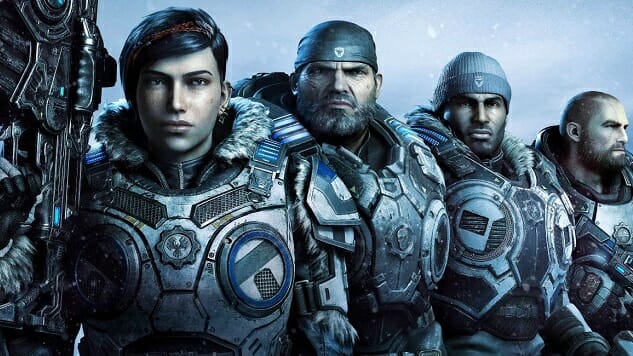Gears of War 5 Is One Bleak House Party

Gears 5 wants the world. It wants to be a gripping, heart-breaking meditation on war, loss, trauma, and the struggle to define oneself. It also wants to be the same adrenaline-fueled romp featuring chainsaw guns that Gears of War has always been while also striving to take the series in bigger, bolder directions. The act of playing through Gears 5 is the gradual realization the game (a series of strangely compelling contradictions all tangled up in one another like a box of cords) isn’t capable of being the gore-caked miracle worker it yearns to be. Luckily, there’s still a lot of fun to be had in spite of the stumbling.
It’s honestly kind of astonishing how close the latest Gears comes to being damned by its own ambitions. The story, focusing mostly on Kait from Gears of War 4 as she searches all across the planet Sera to uncover a dark family secret, tackles a lot of heavy themes. This isn’t new for Gears of War, which has often grown its campaigns from the broken soil of climate change, genocide, and weapons of mass destruction. Even in that context Gears 5 is so brutal it easily eclipses all the others when it comes to despair. However, the problem here is that brutality is so casual, so emotionally unconcerned with the characters it butchers and the cataclysmic events that befall the denizens of Sera that there’s never a satisfying moment to process what’s happened. At least in Gears of War 3, Dom’s death has meaning because it’s the conclusion to a trilogy-length subplot about him trying to reunite with his wife. His despair is constant, inescapable, sometimes even annoying. Is it the stuff clichés are made of? Sure. However, it’s something to go on, an emotional anchor to character and his eventual fate.
In Gears 5, the bodies drop by the busload and I can’t tell you what any of their deaths mean outside of brief, diminishing moments of emotional nausea. The plot is so focused on speeding along from beat to beat with little-to-no meditation on what the hell just happened. There was one instance in my playthrough where I failed to save a fellow and disposable a.i.-controlled grunt in the midst of an intense battle. I was frantically reloading my rifle and could do nothing but watch in horror as an enemy pulled him across a barrier to rip him to pieces. That moment carried more emotional gravitas than anything in the story because it was the only time the sense of futility and helplessness Gears 5 spends so much time harping on came across. Despite the campaign’s plot being a fast and frantic exercise in misery porn, the actual playing of Gears 5 is enjoyable. Unfortunately that has little to do with anything new this entry brings to the table.

The crowning achievement of Gears of War is its over-the-top combat. Everything is so utterly ridiculous, enjoyably so. Repurposed mining tools will drop explosive drills into enemies’ bodies to make them explode in a twister of gore, and there are few things more sickly satisfying in shooters than pulling off a symphony of five splashy headshots with the hefty Boltok, Gears’ answer to Dirty Harry’s .44 Magnum. All of these things are still fun and even improved upon thanks your robotic squadmate JACK, who you can direct to lend you aid in useful ways. He can pop down barriers in front of you, blind enemies to stun them, and even freeze them so you do double damage – an essential tactic for taking down some of the bigger monsters. None of JACK’s abilities revolutionize Gears’ messy but timeless take on ducking in and out of cover and reducing foes to red goo with bullets, but it does add an extra tactical layer that makes gunfights more interesting and is a feature that isn’t mired in frustration. The same cannot be said for this entry’s structure, however.
-

-

-

-

-

-

-

-

-

-

-

-

-

-

-

-

-

-

-

-

-

-

-

-

-

-

-

-

-

-

-

-

-

-

-

-

-

-

-

-








































